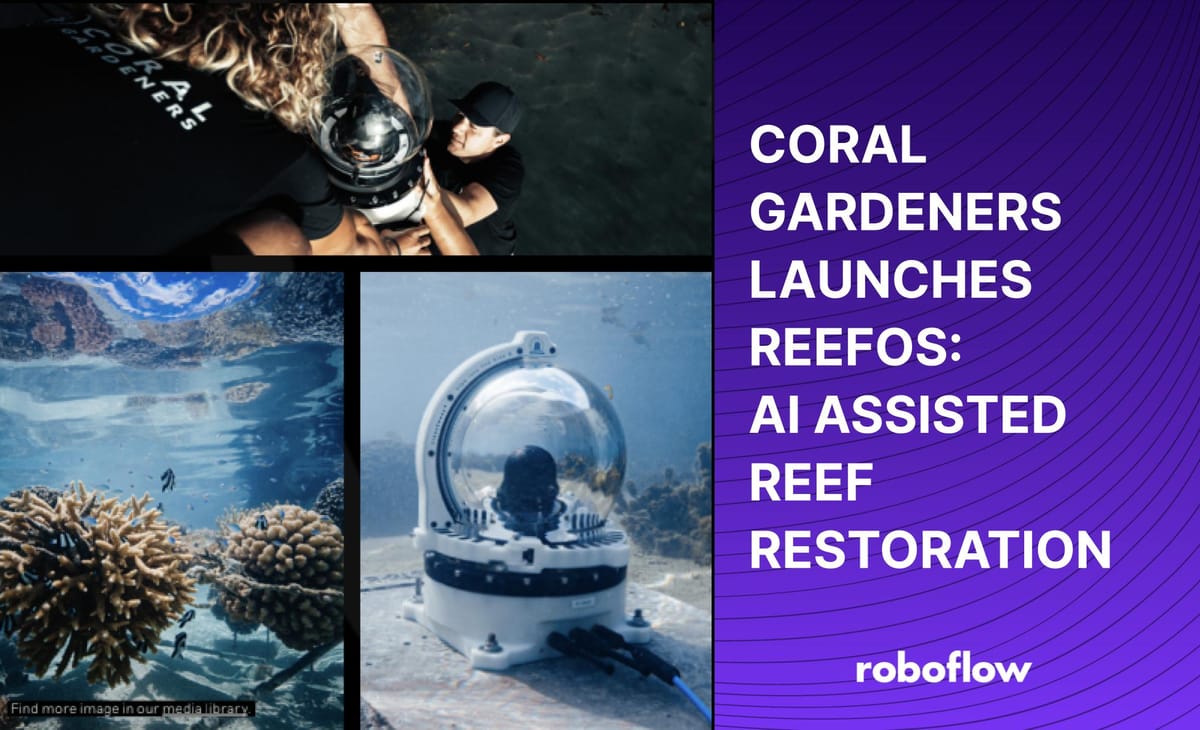
Corals lay the foundation for reefs that are home to nearly 25% of all marine life, but today they are vanishing at an alarming speed. Reefs around the world are degrading and without a concerted intervention, the Earth’s coral reefs as we know them could disappear before the next century.
Coral Gardeners, an organization that grows and plants resilient corals to restore reef ecosystems, has recently launched ReefOS, an AI platform enabling everyone to survey corals in real-time and help save them. This project harnesses the power of computer vision to build an automated monitoring platform for the health of coral reef ecosystems. ReefOS has installed sensors and aquatic cameras in the nurseries and reefs in the island of Mo’orea which provide a 360 view of Coral Gardener’s restored reef, as well as coral fragments being grown nearby. The cameras are connected to cloud servers, collecting data from these systems, and are in the process of labelling and training an AI model for automated monitoring of the reefs.
Traditional reef monitoring techniques are time consuming and expensive, requiring a scientist in the water with limited amounts of air supply. Additionally, just having a human present changes the ecosystem. For example, when a scientist enters the water to make an assessment, many of the fish will hide. Computer vision enables building an objective evaluation of coral reef ecosystem health without the disturbance of the presence of humans. “When we observe with the camera with no humans present there is so much more life to see,” said Dr. Drew Gray, Head of Coral Gardener Labs, and co-founder of Fathom Ocean, the creator of the aquatic cameras (formerly View Into The Blue). “One of our favorite sayings is ‘you can’t improve something if you can’t measure it.’ By measuring the reef health during and after our restoration efforts, we can quantify what impact we had on the ecosystem and use this feedback to improve our methods. The main challenges are getting data to and from the sensors and cameras, annotating the data, and deploying trained AI models that can extract important metrics from the sensor data. To restore the world’s reefs, restoration needs to be far cheaper and far more scalable. This will help address globally scaling reef restoration.”

The Coral Gardeners team will be able to analyze other measurements like water parameters that will help them take data-driven decisions to protect corals. “ReefOS will help us monitor the fish abundance and biodiversity as well as the growth of our corals,” explains Titouan Bernicot, Founder & CEO of Coral Gardeners. “This is our goal; this is why we plant corals to regrow reefs and bring marine life back. This is the beginning of something very exciting. The restoration team and Coral Gardener Labs are developing our AI and once it is optimized, we will be able to connect more nurseries and more reefs to track our impact, around our island of Mo’orea but also around the world. The more we understand reefs, the more we can do to save them – and help save our planet and ourselves.” Over time, the data provided by ReefOS will enable the Coral Gardeners to identify biodiversity trends and understand how this relates to their restoration efforts.
To evaluate fish abundance and biodiversity, the Coral Gardeners are developing ReefOS, an AI model that recognizes fish to provide live and real-time analytics of the over 800 fish species in French Polynesia. In order to do so, they need a lot of data which is time consuming and expensive. With the help of Roboflow's labelling tool, they have been labeling individual fish species from the thousands of pictures collected from a unique underwater camera developed by Fathom Ocean (formerly View Into The Blue).
In addition to their beauty, reefs buffer shorelines from impact of hurricanes, and an estimated 500 million people’s livelihood come from fishing stocks and tourism reefs provide. Reef animals have also been demonstrating possibilities for new drugs to treat cancer and other diseases. Sadly, warming waters, pollution, overfishing, ocean acidification are killing reefs around the world -- restoration efforts utilizing computer vision technology offer hope for conservation efforts and the sustainability of coral reefs.
“Ever since I started to plant corals when I was 16 years old, I already had this idea of connected reefs to scale up reef restoration. I dreamt of seeing my corals grow in real-time and of taking people underwater so that they too could witness the beauty and fragility of this other universe. Today, it feels like a dream has come true as I work with top engineers from Silicon Valley, scientists and my friends from the restoration team in developing an AI model to improve our reef restoration,” explained Titouan Bernicot, founder and CEO of Coral Gardeners.
Coral Gardeners’ mission is to revolutionize ocean conservation and generate collective action to save the world’s coral reefs. They believe in the power of technology and creativity to push the boundaries of ocean conservation. Stay tuned for more exciting updates on ReefOS and how you can help!
Learn more about ReefOS:
Cite this Post
Use the following entry to cite this post in your research:
Roboflow Universe. (Oct 28, 2021). ReefOS: Supercharging Coral Reef Restoration with AI. Roboflow Blog: https://blog.roboflow.com/reefos-supercharging-coral-reef-restoration-with-ai/
